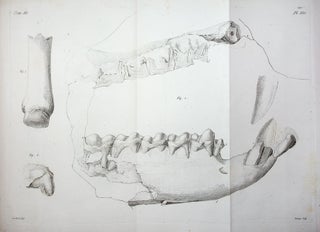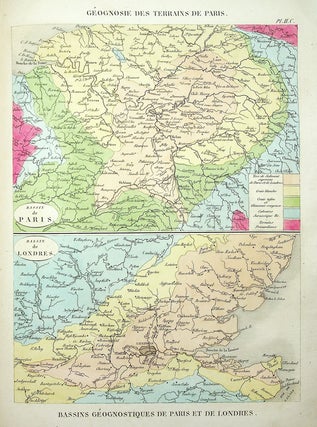![[Item #57403] Recherches sur les Ossemens Fossiles, Où l'on Rétablit Les Caractères de Plusieurs Animaux Dont Les Révolutions du Globe Ont Détruit les Espèces. CUVIER, eorges.](https://lornebair.cdn.bibliopolis.com/pictures/57403.jpg?auto=webp&v=1646347142)
Recherches sur les Ossemens Fossiles, Où l'on Rétablit Les Caractères de Plusieurs Animaux Dont Les Révolutions du Globe Ont Détruit les Espèces
Paris: Dufour et E. D'Ocagne, 1825. Third edition. Quarto (32cm). Seven volumes, complete, in modern half black morocco, green cloth over boards, titled in gilt on spines and fronts; modern marbled endpapers; vol. I: [vi],194,340pp; vol. II part I: [iv],IV,237,[1],[229]-232pp; vol. II part 2: [iv],[239]-648pp; vol. III: [iv],412pp; vol. IV: [iv],514pp; vol. V part 1: [iv],405,[1]pp; vol. V part 2: [iv], 547,[1]pp; 277 engraved plates (including frontispiece, one plate with hand color, and 2 maps), 1 letterpress folding table. Straight and sound, with occasional scattered browning and soil, a few page corners neatly restored, one plate margin trimmed close to image area, but largely clean and bright: Very Good.
Third edition of the work in which Cuvier demonstrated the reality of extinction, through detailed examination of fossils; a cornerstone work in paleontology, biology, and geology. Earlier editions appeared in 1812 and 1821-24. When Cuvier began his research in the late eighteenth century, it was generally believed that no species had ever gone extinct. "Taking for his field the little-known fossil quadrupeds, and applying to them the principles of comparative anatomy, Cuvier astonished the world by reconstructing prehistoric forms of animal life whose existence had never been suspected" (Glass, Temkin, & Straus, Forerunners of Darwin 253). He established extinction as a fact, demonstrated that the age of the earth was greater than six thousand years, and did much to establish the fields of comparative anatomy and paleontology.
However, Cuvier forcefully opposed pre-Darwinian theories of evolution. In the introduction to Ossemens Fossiles, later published separately as Discours sur les révolutions de la surface du globe (1826), Cuvier argued in favor of catastrophism–the theory that violent catastrophes like the Biblical flood had caused extinction events and shaped geological features. This theory left room for contemporaries to infer a divine force that caused catastrophes and created new species; thus, his research "provided a safety valve . . . between the push of geology and the drag of theology" (Forerunners 255). His theories were in part disproven by Darwin and Lyell, who demonstrated that both species and geological formations undergo gradual change over time; but Cuvier's ideas about catastrophism were vindicated by more recent research into mass extinction events caused by volanic eruptions and asteroids. This edition not in Ward/Carozzi.
Price: $4,000.00




